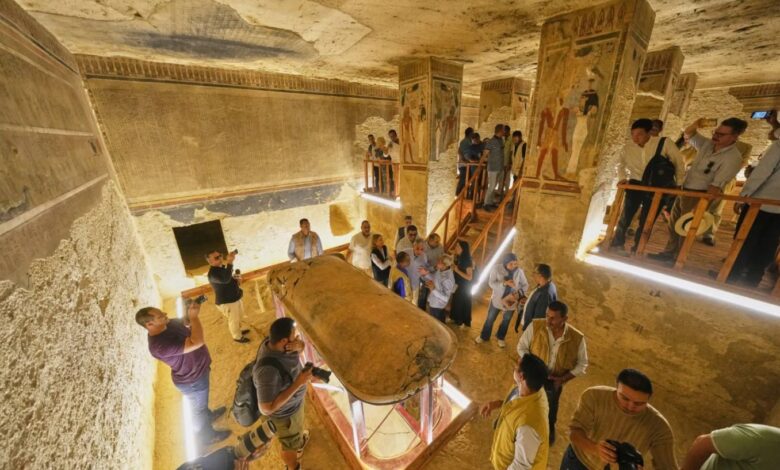
The Minister of Tourism and Antiquities, Sherif Fathy, inaugurated the tomb of Amenhotep III on Tuesday in the Valley of the Kings, west of Luxor, following the finalization of restoration work.
International delegations representing UNESCO and the Japanese Embassy, as well as several ministry officials and restoration experts, participated in the opening.
The attendees toured the tomb and expressed their awe at the beauty of the engravings and colors, which have been restored to their original splendor.
The tomb has now become an artistic masterpiece, confirming that Luxor will remain the capital of history and a global destination for lovers of ancient Egyptian civilization.
Fathy emphasized that the opening of the tomb represents a new message that Egypt is one of the greatest countries in preserving its human heritage.
He added that the state continues to preserve its antiquities, which represent one-third of the world’s antiquities, and that the treasures uncovered from its subsoil continue to amaze the world.
Fathy pointed out that this project embodies the fruitful cooperation between Egypt and its international partners in preserving world heritage.
The massive restoration project began in 2004 in three phases. The first phase ran from 2004 to 2010, the second phase from 2010 to 2017, and the third phase from 2023 to 2024.
The project was supported by the Japanese government in cooperation with UNESCO.
A tomb of royalty
The tomb of King Amenhotep III, carved on the west bank of the historic city of Luxor, is one of the oldest royal tombs discovered in the ancient Theban Necropolis.
In addition to its age, the tomb also derives its importance from the stature of its owner, Pharaoh Amenhotep III, whose reign marked one of the most prosperous periods in ancient Egypt politically, economically, and in art and architecture.
The tomb was first discovered in 1799 by French engineers Prosper Jollois and Édouard de Villiers de Terragues as part of Napoleon Bonaparte’s campaign in Egypt.
The tomb had been closed to visitors for a long time due to its deteriorated condition.
The tomb of Amenhotep III includes two chambers dedicated to the burial of the king’s wives, Queen Tiye and Queen Sitamun, two of the most famous queens of Ancient Egypt, and his daughters.
The two chambers are located adjacent to the main chamber dedicated to the king, and each chamber contains a stone column in addition to a small side chamber.
Amenhotep III died after ruling Egypt for 38 years.




